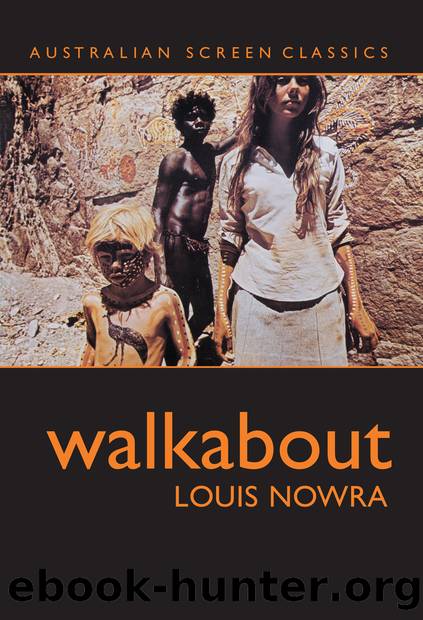Walkabout by Louis Nowra

Author:Louis Nowra
Language: eng
Format: epub
Publisher: Currency Press
After the frantic collision of images and scenes the sequence fades into night. The White Boy is asleep but something has been aroused in both the Girl and the Black Boy. Even if she doesnât know what is churning away in her unconscious, nature describes it for us when Roeg shoots the fork of the smooth white tree from an angle that deliberately gives the impression that we are looking down a pair of white legs into a vagina. The Black Boy makes the first move and approaches her. Confused, she doesnât know how to react. Realising he has been rejected, the Aborigine walks off to stand pensively on a ridge in a hunterâs resting position to wait for dawn. Roeg uses images and sounds to convey the Girlâs perturbed state of mind. The setting and rising of the sun is tracked through a series of dissolves while an aural collage symbolically acts out her confusion. There are the faint sounds of her father calling âCome out now!â intermingled with radio static and a voice announcing âNothing can ever be created or destroyedâ. As the big ball of the sun finally slips down behind the horizon there is a pervasive sense that her unconsciousness has resolved nothing. Fate is moving inexorably on the three of them.
There is another sudden and, at first, bewildering change of location. The trio are now on the sodden banks of a stagnant swamp and, because the White Boy hasnât listened to his sisterâs warning not to take off his shirt, his back is badly burnt. While the Aborigine rubs kangaroo fat on him to relieve the pain, the Girl, adopting the role of a mother, cannot stop herself from sternly rebuking her brother. Itâs an interesting moment because, for all the experience she will undergo through the journey, the callous part of the Girlâs personality never softens, something that later on almost repulses us.
If the swamp is an abrupt change of location, the next sequence is even more so. Rejecting geographical reality, the trio now appear in a verdant valley filled with ancient palms and weirdly inappropriate animals like possums. These sudden, clearly implausible shifts in location and the misplaced animals would give a literal viewer pause to think. But Roeg is shifting the story onto a realm closer to a fairy story. Fairytales isolate aspects and objects and give them a fetishistic potency, hence the vividness and significance of such objects as rings, swords, clothes, long hair, cauldrons, animals and even nature itself. These things are pulled out of their realistic context and ascribed deeply symbolic values. In Walkabout one sees this constantly, from the quandong tree in its proud aloneness, to the totemic school clothes, to the radio which, as anyone would know, could never pick up a radio station so far in the Outback (and with such an absurdly clear reception). The characters in fairytales inhabit a world that disrupts our normal idea of cause and effect. In the dreamlike logic of
Download
This site does not store any files on its server. We only index and link to content provided by other sites. Please contact the content providers to delete copyright contents if any and email us, we'll remove relevant links or contents immediately.
Naked as Nature Intended by Pamela Green(417)
The Filmmaker's Guide to Creatively Embracing Limitations: Not Getting What You Want Leading to Creating What You Need (for True Epub) by Pace William & Stobbe Ingrid(412)
30 Movies to Get You Through the Holidays by Roger Ebert(388)
Bond, James Bond by Brad Gilmore(352)
It's Only a Movie! by Haberski Jr. Raymond J(321)
Chinese films in focus II by Unknown(280)
How To Write A Novel The Easy Way Using The Pulp Fiction Method To Write Better Novels: Writing Skills by Jim Driver(269)
The Fellowship of the Knits: Lord of the Rings: The Unofficial Knitting Book by Tanis Gray(266)
Smartphone Cinema: Making Great Films with Your Mobile Phone by Bart Weiss(265)
Film Truth; November, 1920 by Anonymous(259)
Charles McGraw by Alan K. Rode(257)
The Greatest Show on Earth by Jerry Pinto(253)
Thomas Mann and Friedrich Nietzsche: Eroticism, Death, Music, and Laughter by Caroline Joan Picart(233)
The Garden in the Machine by Unknown(232)
Jafar Panahi: Interviews by Unknown(230)
The Reel Truth by Reed Martin(229)
Jurassic Park and Philosophy by Watkins Jessica Michaud Nicolas(226)
The Japanese Cinema Book by Hideaki Fujiki & Alastair Phillips(219)
Euro-Visions: Europe in Contemporary Cinema by Mariana Liz(217)
